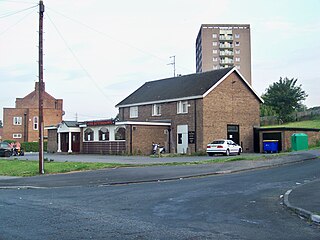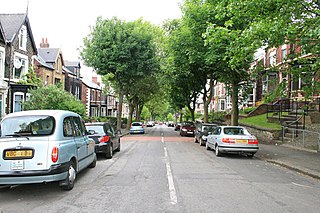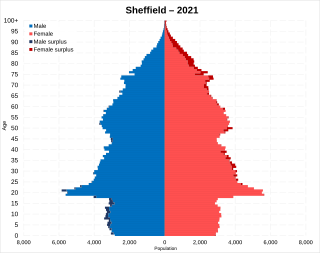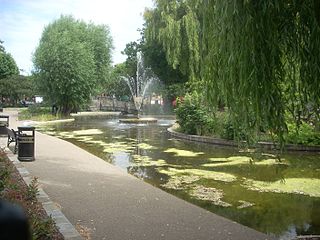Attercliffe is an industrial suburb of northeast Sheffield, England on the south bank of the River Don. The suburb falls in the Darnall ward of Sheffield City Council.

Spitalfields is a district in the East End of London and within the London Borough of Tower Hamlets. The area is formed around Commercial Street and includes the locale around Brick Lane, Christ Church, Toynbee Hall and Commercial Tavern. It has several markets, including Spitalfields Market, the historic Old Spitalfields Market, Brick Lane Market and Petticoat Lane Market. It was part of the ancient parish of Stepney in the county of Middlesex and was split off as a separate parish in 1729. Just outside the City of London, the parish became part of the Metropolitan Board of Works area in 1855 as part of the Whitechapel District. It formed part of the County of London from 1889 and was part of the Metropolitan Borough of Stepney from 1900. It was abolished as a civil parish in 1921.

Dronfield is a town in North East Derbyshire, England, which includes Dronfield Woodhouse and Coal Aston. It lies in the valley of the River Drone between Chesterfield and Sheffield. The Peak District National Park is three miles (4.8 km) to the west. The name comes from the Old English Dranfleld, probably meaning an open land infested with drone bees.

Broomhill and Sharrow Vale — which includes the districts of Broomhill, Broomhall, Crookesmoor, Endcliffe, Sharrow Vale and Tapton Hill — is one of the 28 electoral wards in City of Sheffield, England. The ward was created following the 2015 local government boundary review out of parts of the old Broomhill, Central and Nether Edge wards. It is located in the western part of the city. The population of the Broomhill ward in 2011 was 16,966 people in 5,708 households, covering an area of 2.7 km2. Broomhill & Sharrow Vale is one of the wards that make up the Sheffield Central Parliamentary Constituency.

Beeston is a suburb of Leeds, West Yorkshire, England located on a hill about 2 miles (3 km) south of the city centre.
Crosspool is a suburb of the City of Sheffield, South Yorkshire, England, located 2.5 miles (4 km) west of the city centre. The suburb falls within the Crookes ward of the City of Sheffield. It is a middle class residential area in an elevated position above the Porter and Rivelin valleys and stands at around 660 feet (200 m) above sea level. Crosspool is situated on the A57 road and is the last suburb on that road before the city boundary and open countryside is reached. In 2011 Crosspool had a population of 6,703.

Farnley is a district in Leeds, West Yorkshire, England, 2 miles (3.2 km) south-west of Leeds city centre, between Wortley, Bramley and the countryside around Pudsey and Gildersome, in the LS12 Leeds postcode area. It is part of the Leeds City Ward Farnley and Wortley with a population of 24,213 according to the 2011 Census. New Farnley is a nearby commuter village.

Whirlow is a suburb of the City of Sheffield in England, it lies 3.7 miles (6 km) south-west of the city centre. The suburb falls within the Dore and Totley ward of the City. It is one of the most affluent areas of Sheffield, with much high class housing and several notable small country houses within it. During the Victorian era it was home to some of Sheffield's most influential citizens. Whirlow straddles the A625, the main Sheffield to Hathersage road. The suburb covers the area from Parkhead in the north to Whirlow Bridge in the south and from Ecclesall Woods in the east to Broad Elms Lane in the west. Whirlow had a population of 1,663 in 2011.

The areas of Sheffield, a city and metropolitan borough in the north of England, vary widely in size and history. Some of the areas developed from villages or hamlets, that were absorbed into Sheffield as the city grew, and thus their centres are well defined, but the boundaries of many areas are ambiguous. The areas of Sheffield do not play a significant administrative role, but the city is divided into 28 electoral wards for local elections and 6 parliamentary constituencies for national elections.

Pitsmoor is a former village, now a suburb of Sheffield, England. The name derives from Or-pits as, anciently, the main local industry was the mining of ore. The village falls within the Burngreave ward of the City.

Warsash is a village in southern Hampshire, England, situated at the mouth of the River Hamble, west of the area known as Locks Heath and south of Sarisbury. Boating plays an important part in the village's economy, and the village has a sailing club. It is also home to the Warsash Maritime Academy, part of Southampton Solent University, which provides training for Merchant Navy Officers from around the world.

Abbeyfield is a park in Pitsmoor, Sheffield, South Yorkshire, England, bought by the City Corporation in 1909. The park comprises the park itself, a bowling green, as well as Abbeyfield House, a former secondary school. Abbeyfield School opened in 1919 and was the first school to be built outside Sheffield city centre as a result of the 1902 Act. The number of pupils was high and the school soon proved to be too small, children being split in numerous classes in several neighbouring churches. Brush House was converted into a school and some classes moved to that location. Abbeyfield House closed in September 1927 and all pupils moved to Brushes, then called Firth Park Secondary School.

The latest (2021) population estimate for the City of Sheffield is 556,521 residents. This represents an increase of about 17,000 people since the last census in 2011.

Clapton Pond is a pond and garden at Clapton in the London Borough of Hackney.
Walkley is a suburb of Sheffield, England, west of Burngreave, south of Hillsborough and north-east of Crookes.
Netherthorpe is a suburb of the City of Sheffield in England. It is one mile (1.6 km) west of the city centre. It is mostly an area of local government built housing situated on a considerable slope running downhill from the Brook Hill roundabout, at a height of 350 feet (107m), towards the Shalesmoor roundabout at a height of 160 feet (50m) over a distance of half a mile (1 km). It is bounded by the suburbs of Upperthorpe to the north, Crookesmoor to the west and the dualled Inner Ring Road to the east. The suburb falls within the Walkley ward of the City.

Christ Church is an Anglican church in the Pitsmoor district, north of Sheffield City Centre in England. It is a Grade II listed building.

St Thomas is a former Anglican church in the Brightside area of Sheffield in England which now serves as a circus training school.





















